
HMS Hurricane was an H-class destroyer that had originally been ordered by the Brazilian Navy in the late 1930s with the name Japura, but was bought by the Royal Navy after the beginning of World War II in September 1939 and later renamed. When completed in June 1940, the ship was temporarily assigned to the Home Fleet before she began escorting convoys and conducting anti-submarine patrols. She was badly damaged during a German air raid on Liverpool in May 1941 and her repairs were not completed until the beginning of 1942. Hurricane was then assigned as the flotilla leader of Escort Group B1 assigned to the Mid-Ocean Escort Force, escorting convoys in the North Atlantic for the next two years. The ship was torpedoed by a German submarine on Christmas Eve 1943, and had to be scuttled the next day as she was unable to steam back to port.
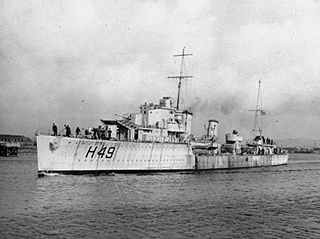
HMS Inconstant was an I-class destroyer built for the Turkish Navy, but was purchased by the Royal Navy in 1939.

HMS Garland, also known by her Polish designation ORP Garland, was a G-class destroyer built for the Royal Navy in the mid-1930s. During the Spanish Civil War of 1936–1939 the ship spent considerable time in Spanish waters, enforcing the arms blockade imposed by Britain and France on both sides of the conflict. Shortly after World War II began, she was badly damaged by the premature explosion of her own depth charges and required over six months of repairs. Before these were completed, Garland was loaned to the Polish Navy in May 1940. The ship was assigned to the Mediterranean Fleet afterwards and escorted convoys there before being assigned to the Western Approaches Command in September for escort duties. She escorted a convoy from Gibraltar to Malta during Operation Halberd in September 1941 and escorted Convoy PQ 16 from Iceland to Murmansk in May 1942. She was badly damaged by a near miss from a German bomber during that operation and required three months of repairs.
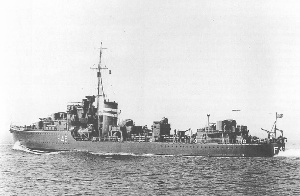
HMS Juno was a J-class destroyer of the Royal Navy laid down by the Fairfield Shipbuilding and Engineering Company, Limited, at Govan in Scotland on 5 October 1937, launched on 8 December 1938 and commissioned on 25 August 1939. Juno participated in the Battle of Calabria in July 1940 and the Battle of Cape Matapan in March 1941.

HMS Kandahar (F28) was a K-class destroyer built for the Royal Navy during the 1930s, named after the Afghan city of Kandahar.

HMS Zulu was a Tribal-class destroyer of the Royal Navy and the second ship to bear the name. Built in Glasgow by Alexander Stephen and Sons, her keel was laid down on 10 August 1936, she was launched on 23 September 1937 and commissioned on 7 September 1938.

ORP Piorun was an N-class destroyer operated by the Polish Navy in World War II. The word piorun is Polish for "Thunderbolt". Ordered by the Royal Navy in 1939, the ship was laid down as HMS Nerissa before being loaned to the Poles in October 1940 while still under construction.
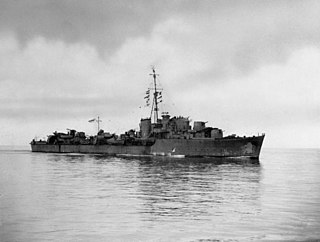
HMS Panther was a P-class destroyer built for the Royal Navy during the Second World War. After commissioning on 12 December 1941, she made a short trip to Iceland with the battleship King George V, then escorted a British convoy to India. In early April 1942, Panther rescued survivors from two cruisers sunk in the Indian Ocean, after which she took part in Operation Ironclad, the Allied invasion of Vichy French-held Madagascar, and sank a French submarine with another destroyer. Panther then returned to the Mediterranean, and participated in the Allied landings in North Africa, but was severely damaged in an air attack and had to undergo repairs in Gibraltar. After taking on survivors from the torpedoed SS Strathallan, Panther escorted two Allied convoys in the Atlantic. She next supported the Allied attack on Sicily, then sailed to the Aegean Sea in the Dodecanese Campaign. On 9 October 1943, Panther was sunk by German Stuka dive-bombers with 33 dead.

HMS Nubian was a Tribal-class destroyer of the Royal Navy that saw much distinguished service in World War II. She won 13 battle honours, a record only exceeded by one other ship, and matched by two others.

HMS Escapade was an E-class destroyer built for the Royal Navy in the early 1930s. Although assigned to the Home Fleet upon completion in 1934, the ship was attached to the Mediterranean Fleet in 1935–1936 during the Abyssinia Crisis. During the Spanish Civil War of 1936–1939 she spent considerable time in Spanish waters, enforcing the arms blockade imposed by Britain and France on both sides of the conflict. Escapade was assigned to convoy escort and anti-submarine patrol duties in the Western Approaches when World War II began in September 1939, but transferred back to the Home Fleet at the end of the year.

HMS Havelock was an H-class destroyer that had originally been ordered by the Brazilian Navy with the name Jutahy in the late 1930s, but was bought by the Royal Navy after the beginning of the Second World War in September 1939 and later renamed. She participated in the Norwegian Campaign in May 1940 and was assigned to convoy escort and anti-submarine patrols with the Western Approaches Command afterwards. The ship was briefly assigned to Force H in 1941, but her anti-aircraft armament was deemed too weak and she rejoined Western Approaches Command. Havelock became flotilla leader of Escort Group B-5 of the Mid-Ocean Escort Force in early 1942 and continued to escort convoys in the North Atlantic for the next two years. The ship was converted to an escort destroyer and sank one submarine during the war. After the end of the war, she escorted the ships carrying the Norwegian government in exile back to Norway and served as a target ship through mid-1946. Havelock was scrapped beginning in late 1946.

HMS Highlander was an H-class destroyer that had originally been ordered by the Brazilian Navy with the name Jaguaribe in the late 1930s, but was bought by the Royal Navy after the beginning of World War II in September 1939 and later renamed. When completed in March 1940, she was assigned to the 9th Destroyer Flotilla of the Home Fleet. The ship was assigned to convoy escort duties in June with the Western Approaches Command, sinking one German submarine in October. Highlander was transferred to Freetown, Sierra Leone, in mid-1941 to escort convoys off West Africa, but returned to the United Kingdom in August. She became flotilla leader of Escort Group B-4 of the Mid-Ocean Escort Force in early 1942 and continued to escort convoys in the North Atlantic for the rest of the war. The ship became a target ship after the war ended and was sold for scrap in mid-1946.
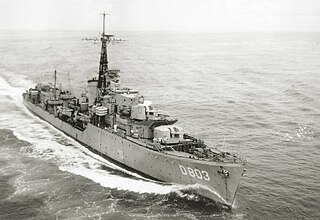
HNLMS Van Galen was a N-class destroyer built for the Royal Navy during the Second World War and transferred to the Royal Netherlands Navy shortly after completion. The Dutch changed the pennant numbers several times G-84, J-3, JT-3, and D-803.

HMS Crusader was a C-class destroyer built for the Royal Navy in the early 1930s. She saw service in the Home and Mediterranean Fleets and spent six months during the Spanish Civil War in late 1936 in Spanish waters, enforcing the arms blockade imposed by Britain and France on both sides of the conflict. Crusader was sold to the Royal Canadian Navy (RCN) in 1938 and renamed HMCS Ottawa. She was initially deployed on the Canadian Pacific Coast before World War II, but was transferred to the Atlantic three months after the war began. She served as a convoy escort during the battle of the Atlantic until sunk by the German submarine U-91 on 14 September 1942. Together with a British destroyer, she sank an Italian submarine in the North Atlantic in November 1941.

HMS Comet was a C-class destroyer built for the Royal Navy in the early 1930s. She saw service in the Home and Mediterranean Fleets and the ship spent six months during the Spanish Civil War in late 1936 in Spanish waters, enforcing the arms blockade imposed by Britain and France on both sides of the conflict. Comet transferred to the Royal Canadian Navy (RCN) in 1938 and renamed HMCS Restigouche. During World War II, she served as a convoy escort in the battle of the Atlantic, on anti-submarine patrols during the invasion of Normandy, and was employed as a troop transport after VE Day for returning Canadian servicemen, before being decommissioned in late 1945. Restigouche was sold for scrap in 1946.

HMS Cygnet was a C-class destroyer built for the Royal Navy in the early 1930s. The ship was initially assigned to the Home Fleet, although she was temporarily deployed in the Red Sea during the Abyssinia Crisis of 1935–36. Cygnet was sold to the Royal Canadian Navy (RCN) in late 1937 and renamed HMCS St. Laurent. She was stationed on the west coast of Canada when World War II began in September 1939, and had to be transferred to the Atlantic coast for convoy escort duties. She served as a convoy escort in the Battle of the Atlantic and participated in the sinking of two German submarines. The ship was on anti-submarine patrols during the invasion of Normandy, and was employed as a troop transport after VE Day for returning Canadian servicemen. St. Laurent was decommissioned in late 1945 and scrapped in 1947.
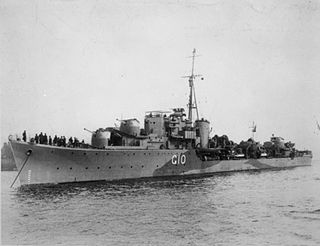
HMS Pathfinder was a P-class destroyer built for the Royal Navy during the Second World War. She was damaged while serving in the Far East, and was scrapped after the end of the war.

HMS Milne was a M-class destroyer of the Royal Navy which served during World War II. She was equipped as a flotilla leader.
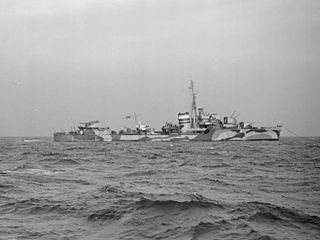
HMS Loyal was a L-class destroyer built for the Royal Navy in the late 1930s, although she was not completed until after World War II had begun.
HMS Rockwood was a Type III, Hunt class Escort destroyer of the Royal Navy, built by Vickers-Armstrongs in Barrow-in-Furness and served during the Second World War. She was damaged in action in November 1943 by a glide bomb, not fully repaired, took no further part in the war and was broken up for scrap in 1946.



















